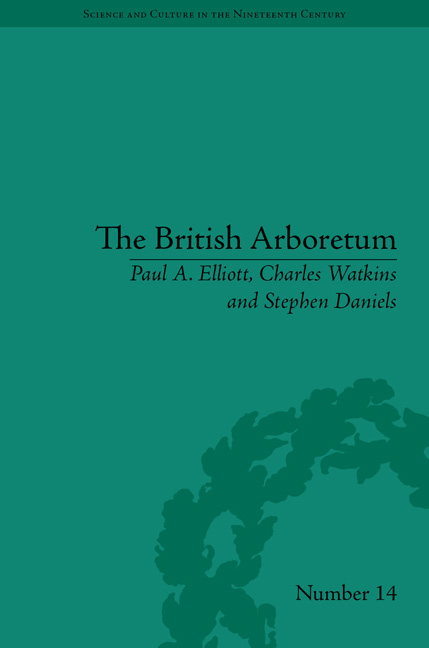Book contents
- Frontmatter
- CONTENTS
- List of Figures
- Preface
- Introduction
- 1 British Tree Cultures in the Nineteenth Century
- 2 Trees and Taxonomy
- 3 British Arboriculture, c. 1800–35
- 4 John Claudius Loudon's Arboretums
- 5 The Botany of the Arboretum Britannicum
- 6 The Derby Arboretum
- 7 Estate Arboretums
- 8 Public Urban Arboretums
- 9 The Transformation of Victorian Public Arboretums
- Conclusion
- Notes
- Works Cited
- Index
5 - The Botany of the Arboretum Britannicum
- Frontmatter
- CONTENTS
- List of Figures
- Preface
- Introduction
- 1 British Tree Cultures in the Nineteenth Century
- 2 Trees and Taxonomy
- 3 British Arboriculture, c. 1800–35
- 4 John Claudius Loudon's Arboretums
- 5 The Botany of the Arboretum Britannicum
- 6 The Derby Arboretum
- 7 Estate Arboretums
- 8 Public Urban Arboretums
- 9 The Transformation of Victorian Public Arboretums
- Conclusion
- Notes
- Works Cited
- Index
Summary
Introduction
The most important scientific message of Loudon's Arboretum Britannicum was that botany was essential to all aspects of arboriculture from the economic and cultural uses of trees and tree products to effective artistic depictions of trees and landscape gardening. This paralleled Loudon's friend and collaborator John Lindley's attempt to place botany on a more rigorous, serious ‘masculinized’ and scientific institutional footing and raise its status in relation to physics and chemistry. With relatively few indigenous species and a flourishing commercial nursery sector, hardy and half hardy trees and shrubs provided a manageable subset of plants and demonstrated the efficacy of the Candollean natural system. The extensive scientific, economic, cultural and statistical information in the Arboretum Britannicum conveyed a sense of weighty learning, authority, professionalism and comprehensiveness whilst satisfying the Victorian desire for natural historical facts, objects and specimens. Loudon was criticized for a lack of moral and religious feeling and content in his applications of science to nature for instance, in relation to garden cemeteries. However, the unrivalled and daunting enumeration of facts that characterized all his works generated a secular form of wonder partially replacing the celebration of divine nature and natural theological assumptions underpinning most early and mid-Victorian natural historical works. The relentless accumulation of information added weight to the core scientific message that modern physical, anatomical and taxonomic botany was essential to modern arboriculture.
- Type
- Chapter
- Information
- The British ArboretumTrees, Science and Culture in the Nineteenth Century, pp. 109 - 134Publisher: Pickering & ChattoFirst published in: 2014



